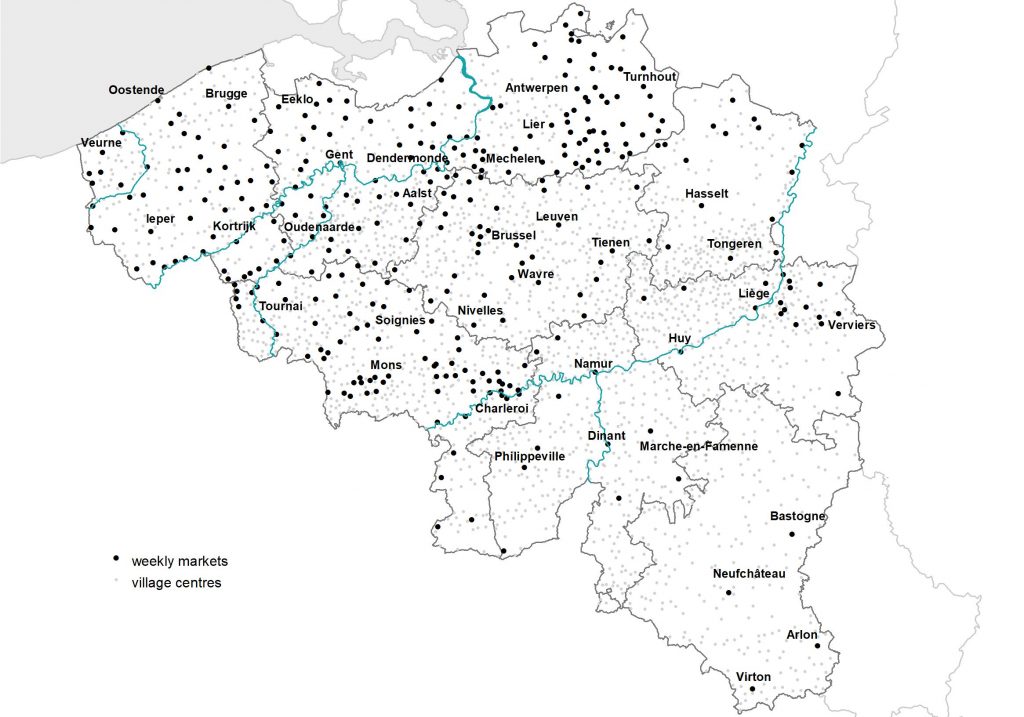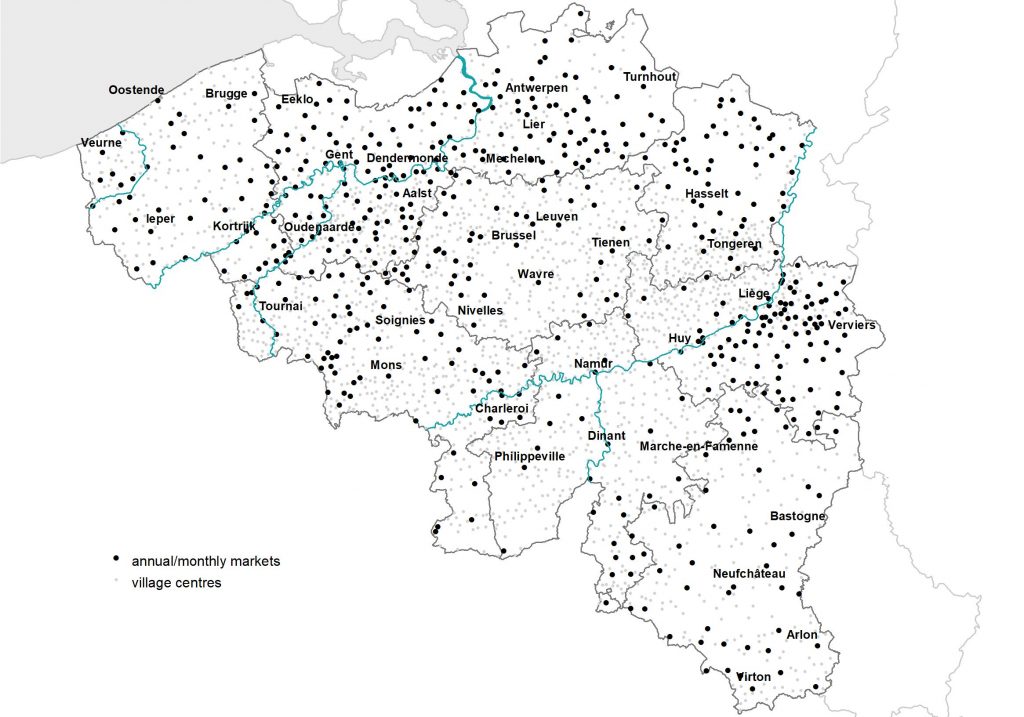ALWAYS A MARKET NEARBY? THE MARKET NETWORK IN FLANDERS THROUGH THE EARLY MODERN PERIOD AND THE NINETEENTH CENTURY
DETAILS
Used Dataset
Datum:
Category:
Author: Wouter Ronsijn
Nowadays, the flower market of Ghent, the bird market of Antwerp and the antiques market of Tongeren are mainly tourist attractions, but where could one go in the past for the weekly market? In the previous blog post, Wouter Ronsijn (UGent) showed how many markets were held in the county of Flanders during the early modern period. In this month’s contribution we learn where markets used to be organised and how this pattern evolved over time.
Old and new markets
In the previous post we discussed the evolution of the number of markets between ca. 1550 and 1800, and the days on which those markets took place. Besides chronological patterns, there were also geographical patterns in the Flemish market network. The overview of Flemish weekly markets between 1550 and 1800, prepared for the STREAM project, has now been transformed into a map. This was enabled by the historical geographical reference system of the STREAM database.
When we compare the maps, we see a shift from coastal Flanders to inland Flanders over the long term. Several markets in coastal Flanders that disappeared after 1550 did not return and there were few new markets in other places in the coastal region. In contrast, many new markets were established in inland Flanders. This trend is undoubtedly linked to the population stagnation in coastal Flanders and the strong demographic growth in inland Flanders.
The markets that were established between 1550 and 1800 were not always new markets. Sometimes markets lapsed for a period and were then restarted. For example, the application for a market in Sint-Lievens-Houtem in 1783 was supported by the various testimonies of elders from the neighbourhood. They had heard from their parents and grandparents that there used to be a market in this village, which had been brought to an end by war.
In addition to the many wars that disrupted life, fluctuations in the establishment of markets were linked to the economic and demographic situation, to power shifts between urban and rural areas, and between higher and lower levels of government. After all, the functioning of markets also depended on potential rivals who could use political power to prevent competition. It was only after 1870 that it was no longer necessary to obtain permission from higher authorities to establish a market and that municipalities could decide on this themselves.
Based on the Farmers’ Yearbook, we can indicate on a map for the whole of Belgium in 1868 where there were weekly (see map 1) and annual markets (see map 2). As far as we know, this is not possible for earlier periods due to a lack of sources.


Note: Because it is sometimes difficult to make the distinction between annual and monthly markets (some municipalities had up to 12 annual markets, making them essentially a monthly market), both have been taken together here.
Large regional differences
The maps immediately make it clear that there were enormous regional differences in Belgium. This is primarily, but not exclusively, due to settlement patterns and population density. Obviously, more markets can be found in areas where the land is divided into many small villages than in areas with only a few sprawling villages. This was the case, for example, in East Flanders and West Flanders, where there were many weekly markets, but not in Haspengouw, where nevertheless there were also many small municipalities. Furthermore, there were many markets in the densely populated, emerging Walloon industrial areas around Mons, La Louvière, Charleroi and to a lesser extent Liège, though also in the much less densely populated Antwerp Campine almost all municipalities had a market. South of the Sambre and Meuse rivers, where few people lived, there were also few markets.
The map for 1868 further reveals that, in addition to settlement patterns and population density, regional economic differences also played a role. The many weekly markets in the Antwerp Campine mainly served to allow local farmers to sell their butter, destined for the big cities among other places, at advantageous prices, whereas the markets in the Walloon industrial areas were probably mainly intended to ensure supplies to local consumers. Annual markets, which in the nineteenth century still played a role in the cattle trade, were remarkably common in the pasturelands around Liège, among other places.
Finally, there are also traces of the power that cities were long able to exercise over nearby rural areas. For example, there are remarkably few markets in the immediate surroundings of a few large cities such as Bruges, Ghent, Antwerp and Brussels. Nevertheless, there were already markets in some municipalities that bordered on those large cities and which were probably already part of the urban agglomeration, such as Borgerhout near Antwerp as well as Schaarbeek and Sint-Jans-Molenbeek near Brussels.
The struggles, physical and verbal, that have been waged over the centuries in and around markets clearly show the importance of this institution. The right to hold markets was contested between urban and rural areas. Buyers and sellers, men and women, farmers, vendors, craftsmen and shopkeepers all fought for access to markets. Markets provided access to and control over trade flows, a direct source of income for sellers, sometimes indirectly for the shopkeepers and innkeepers who welcomed more people on market days, and for authorities that collected taxes at markets. Knowledge of the development of these specific markets is essential for a good understanding of daily life in the past.
If you want to use one of the dataset mentioned above, do not hesitate to contact queteletcenter@ugent.be.
Sources
- UGent Quetelet Center, STREAM database.
- Annuaire des agriculteurs pour 1868, Brussels, Tarlier.
Literature
- Stabel, Peter. De kleine stad in Vlaanderen. Brussels, Paleis der Academiën: 1995.
- Stabel, Peter. Dwarfs among giants. Leuven, Garant: 1997.
- Van Damme, Ilya. Verleiden en Verkopen. Amsterdan, Aksant: 2007.
- van Bavel, Bas. Manors and Markets. Oxford, Oxford University Press: 2010.
- Ronsijn, Wouter. Commerce and the Countryside. Ghent, Academia Press: 2014.
- Ronsijn, Wouter. “Het wettelijke land en het werkelijke land: wetgeving en praktijk bij het houden van openbare markten in België, negentiende eeuw”, Handelingen van de Koninklijke Zuidnederlandse Maatschappij voor Taal- en Letterkunde en Geschiedenis, 2016, 69, pp. 217-232.
- For a recent overview, see www.markten.be and www.belgischemarkten.be